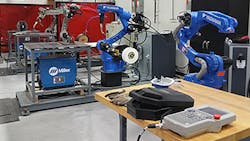Robot installations are estimated to increase an average of 12% per year from 2015 to 2017, according to the International Federation of Robotics. Those IFR statistics note that “human-machine collaboration will open up new applications and attract new customers.”
In spite of the IFR’s findings, the traditional thinking in robotics is that as parts get bigger and heavier, robots must grow in size, too. But labor doesn't work that way, and neither should robots. If a part becomes too big for a human worker to lift, he might tap a jib crane to move the piece into position. Robots can work in the same way and be built on a scale to work alongside humans, using human tools to perform tasks.
There are more opportunities to automate tasks that exist within the average adult’s six-foot wingspan than the very small or very large scale. Think of assembly lines where the manufacturing of smartphones, clothing and toys is largely carried out by humans. There are steps along these lines that include dangerous parts or solvents; those could be handled instead by robots interspersed among workers.
Designing Human-Scale Robots
Employers bring human workers to a job and train them to accomplish a task. They can do the same with robots. In fact, if a company has successfully automated a process, it should be able to pull a robot out of the mix, replace the robot with a human and not see a change.
To be sure, there are challenges to designing and manufacturing human-scale robots. Robots struggle with the non-structured environments that humans can adapt to. Humans, for example, can dexterously use their hands to manipulate a non-rigid object like an extension cord. Robots can’t easily tackle such a task.
Academics are working on lighter, smarter and more sensitive robot arms to address this, but fewer people are looking at how robots simulate the power and control of the human hand to work with tools. Unfortunately, industry is leaving the work of solving the tooling challenge to systems integrators. The systems integrators, or SIs, are the companies charged with integrating robots with a work environment such as an assembly line or conveyor. But SIs rarely have the financial resources of robot manufacturers and they don’t have the depth of research capability possessed by academics. Ultimately, solving the challenge of what happens at the end of the robot’s arm belongs to academics and robot manufacturers.
According to Ken Goldberg, professor of engineering and robotics at UC Berkeley, “Researchers are looking at how humans and robots can work side by side.”
Goldberg says the old model was to keep robots separated in cages, where they undertook dangerous work such as spot welding. Goldberg sees a need for robots that can help humans with tasks that vary from day to day. He recently returned from the IEEE's International Conference on Robotics and Automation in Seattle where discussions and research included choosing specific cameras and controls to help robots understand the compensating techniques that humans use to perform work. Humans have evolved subtle strategies for overcoming obstacles, and the designers of human-scale robots will have to help machines do the same.
“We’re making progress,” Goldberg says. “An area of deep learning is the idea of using humans to demonstrate the motions robots would need.”
Hurdling obstacles
Goldberg says new technology can help robots. By using the cloud to share data across different locations where robots are failing or succeeding at tasks, researchers can collect the experiences from which robots can learn. Goldberg also notes that differences between robot languages and programmable logic controllers (PLCs) had been a problem for robotics. In essence, factory personnel must understand two types of programming to integrate a robot with its workspace. But engineers have solved this challenge by creating software to program and control robots directly from a PLC. It is now in use in industries ranging from consumer package goods to life sciences.
Another obstacle for designing human-scale robots involves the type of hand to use. Goldberg says the human hand has 22 degrees of freedom. But he doesn’t think robots require this same complexity. “A robot screwdriver, for example, could be much simpler,” he says.
One way to address the tooling design challenge at the end of the robot arm is to utilize robots with two arms. With dual-armed robots, one arm can grasp an item, while the second arm performs the task. Additionally, a dual-armed robot can make use of a human lift assist device to increase lifting capacity, while maintaining a minimal footprint – working within the same space as a human.
Creating high-performance, high-dexterity platforms to mimic human behavior requires research and experimentation. When manufacturers put human-scale robots into an assembly line staffed by human workers, the potential for unpredictability or a mishap increases. To mitigate this, the robotics industry and academics alike must focus on how a robot interacts elbow to elbow on the floor with human workers and human tools. Deploying human-scale robots in these settings will require that robot manufacturers consider the ramifications of scaling, as well as ensure predictability and protection for workers.
The payoff for human-scale automation: increased productivity, efficiency and safety.
Chetan Kapoor is senior director of technology innovation for Yaskawa Innovation, Inc. Before its acquisition by Yaskawa America, Inc., Kapoor was founder and CEO of Agile Planet, Inc., a developer of PLC-based motion and robot controllers. He also served as associate director and chief scientist for the University of Texas at Austin, from which he received his doctorate degree in mechanical engineering. You can reach him at [email protected].
